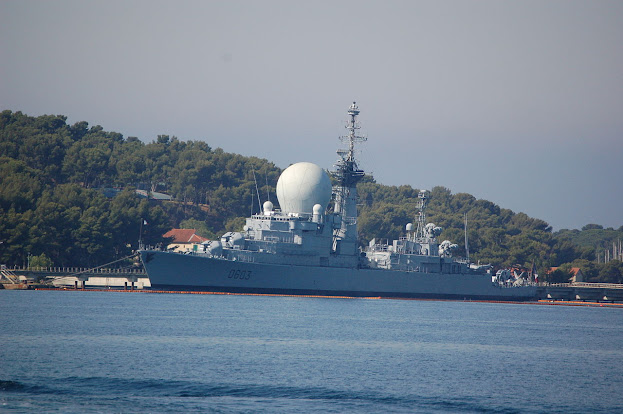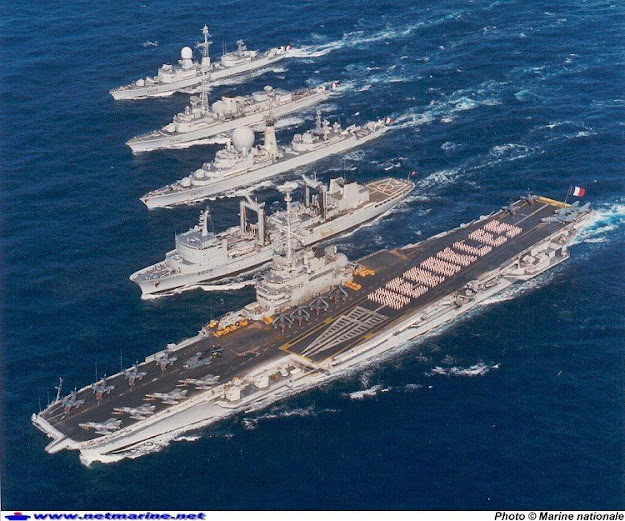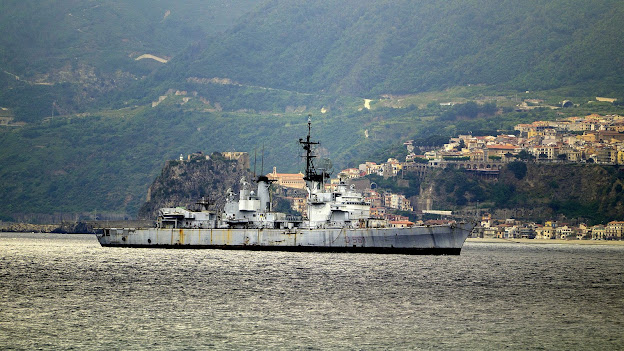La classe Suffren, della Marine Nationale detta anche type F60 FLE, era una classe composta da due fregate lanciamissili (frégates lance-engins - FLE) francesi, la cui unità capoclasse (con numerale D602) è stata impostata nel 1962 ed ha preso servizio nel 1967, la sua gemella è la Duquesne, con numerale D603.
La classe e la nave capoclasse prendono il nome da Pierre André de Suffren de Saint Tropez (1729-1788) viceammiraglio francese, la seconda unità prende il nome da Abraham Duquesne (1610-1688) tenente generale (viceammiraglio) francese.
Le unità erano armate di missili antinave Exocet, di missili antisommergibile Malafon e di missili antiaerei (SAM) navali Masurca, solo tre navi della Marine nationale hanno avuto in dotazione quest'ultimo tipo di missile, le due Suffren e l'incrociatore Colbert (C 611).
Dal 4 febbraio 1967 al 30 marzo 1968 il comandante della Suffren è l'allora capitano di vascello Philippe de Gaulle, figlio del generale de Gaulle, all'epoca Presidente della Repubblica francese.
Le due unità della classe Suffren sono state sostituite dalle due unità della classe Horizon.
Impostata presso i cantieri DCAN di Lorient il 21 dicembre 1962, la fregata missilistica Suffren fu varata il 15 maggio 1965 e ammessa in servizio attivo il 20 luglio 1968. Questa unità aveva una gemella, la Duquesne. La sua missione era quella di garantire la protezione di una forza navale contro minacce aeree, sottomarine o di superficie, e possibilmente intervenire contro costa.
Alla fine della sua prima crociera endurance, si unì alla Escadre de l'Atlantique il 1 aprile 1969, con Brest come porto di base. Nel novembre 1975, si è unito a Tolone alla Squadriglia Mediterranea, prima di essere assegnata alla Forza d'Azione Navale.
Il Suffren è stato posto in una posizione complementare dal 2 aprile 2001. Le condizioni generali della sua attrezzatura, in particolare la propulsione, non consentivano più di garantirne la disponibilità ad un costo contenuto.
L'ultima cerimonia si è svolta il 20 settembre 2001. L'unità fu trasferita alla base navale di Tolone il 19 maggio 2009. Il Suffren è stato radiato il 16 luglio 2009 (n° Q 847). Il suo scafo fu utilizzato come frangiflutti sull'Île du Levant a partire dall'estate 2009, per un periodo di cinque anni.
Le Suffren è stato sponsorizzato dalle città di Saint Tropez dall'ottobre 1967 e Saint Cannat, città natale di Pierre André de Suffren, dal 2 settembre 1989.
- Impostata a Brest il 1° febbraio 1965
- Varato l'11 febbraio 1966
- Messa in servizio attiva il 1° aprile 1970
- Dieppe è una città sponsor dal 25 settembre 1971.
- Annecy è una città sponsorizzata dall'11 marzo 1988.
Missioni
Le missioni essenziali della fregata lanciamissili Duquesne erano la protezione delle navi della flotta contro le minacce aeree, la protezione antisommergibile e, possibilmente, l'azione contro costa.
In particolare, la Duquesne era dotata di un radar tridimensionale a lunghissimo raggio, la cui antenna era protetta da un radome di 11 metri di diametro, che conferiva all'imbarcazione la sua caratteristica silhouette.
Caratteristiche
- Lunghezza: 157,60 metri
- Larghezza: 15,54 metri
- Altezza: 7,25 metri
- Velocità massima: 29 nodi
- Dislocamento: 5.335 tonnellate e 6.780 tonnellate a pieno carico
- Portata: 5.100 miglia nautiche a 18 nodi, 2.000 a 30 nodi
- Autonomia: 45 giorni
Energia e propulsione
- Caldaie: 4 con funzionamento automatico timbrato a 45 kg/cm².
- Vapore surriscaldato: 450°C
- 2 gruppi turbina a ingranaggi Doppio rastrello di riduzione
- 2 eliche
- 54.000 CV (39.690 kW)
- Potenza elettrica: 3.440 kW (2 turbo-alternatori da 1.000 kW, 3 diesel-alternatori da 480 kW)
Apparecchiature elettroniche
- 1 radar DRBI-23
- 1 DRBV-15 A radar
- 2 radar DRBR-51
- 1 DRBC-33 A radar
- 1 radar DRBN-34 (Racal Decca)
- 1 sonar DUBV-23
- 1 Sonar DUBV-43
- 2 disturbatori ARBB-33
- 1 rilevatore ARBR-17
- 2 lanciatori esca Sagaie
- 1 cortina trainata SLQ-25 Nixie Nixie
- 1 sistema di guida da combattimento SENIT 2 (+ link 11)
- 1 trasmissione satellitare Siracusa, Inmarsat
- TACAN: NRBP-2 A
Attrezzatura
- Drôme: 1 EDL 700 e 1 EDO
- 2 gru da 5 tonnellate
- Sistema di comando SEAO/OPSMER
- 2 linee di cottura ottiche Panda
- Infrastruttura per disturbatori BSM
- Il radar di sorveglianza tridimensionale DRBI-23 pesa 28 tonnellate ed è protetto da un radar CVR di 11 metri di diametro.
Armamento
- 1 sistema Masurca (II x 1, 48 missili)
- 4 MM 38 Exocet (I x 4)
- 4 catapulte fisse per siluri ASM L 5 mod 4 (10 siluri)
- 2 torrette 100 AA (I x 2) Mle 64 - 2 pistole 20 AA F2 (I x 2)
- 4 mitragliatrici 12,7 (I x 4)
Equipaggio
- 27 ufficiali
- 220 ufficiali di marina
- 98 quadrimestri e valutazioni.
La fregata antiaerea Duquesne fu impostata a Brest nel febbraio 1965 e ammessa in servizio attivo il 1° aprile 1970. Era un’unità potentemente armata la cui missione era quella di garantire la protezione di una forza navale contro minacce aeree, sottomarine o di superficie e possibilmente intervenire contro costa.
Progettata appositamente per la protezione ravvicinata delle portaerei Clemenceau e Foch, è stata con la Suffren (la sua nave gemella) la prima nave da combattimento missilistica contro aerei, interamente francese nella costruzione e nel design.
Inizialmente con sede a Brest con il gruppo di portaerei, la Duquesne si è unita a Tolone nel luglio 1977, ed è entrata a far parte della Naval Action Force il 1 giugno 1992. Ha preso parte a numerose esercitazioni nell'Atlantico, ha assicurato la presenza della Francia nell'Oceano Indiano da Gibuti nel 1974, 1977, 1981, 1988 e 2000. Ha anche svolto numerose missioni di mantenimento della pace al largo del Libano dal 1982 al 1984 e ha partecipato all'inizio degli anni '90 ad operazioni navali al largo del Libano e dell'ex Jugoslavia.
Con l'entrata in servizio della portaerei Charles de Gaulle, alla Duquesne furono affidate in particolare missioni di scorta per gruppi anfibi, la Marina francese impiegò per accompagnare la portaerei, le fregate Cassard o Jean Bart dotate di link 16 e un più recente SENIT. La fregata Duquesne è stata ritirata dal servizio attivo nel 2008 e sostituita due anni dopo dalla fregata Forbin.
Il Duquesne era sponsorizzato dalle città di Dieppe dal 25 settembre 1971 e di Annecy dall'11 marzo 1988. È inoltre gemellato con il 27° battaglione di cacciatori alpini.
ENGLISH
The Suffren class, of the Marine nationale also called type F60 FLE, was a class made up of two French frégates lance-engins (FLE), whose class leader unit (with numeral D602) was set up in 1962 and took up service in 1967, its twin is the Duquesne, with numeral D603.
The class and the class leader ship are named after Pierre André de Suffren de Saint Tropez (1729-1788) French Deputy Admiral, the second unit is named after Abraham Duquesne (1610-1688) French Lieutenant General (Deputy Admiral).
The units were armed with Exocet anti-ship missiles, Malafon anti-submarine missiles and Masurca naval anti-aircraft missiles (SAM), only three ships of the National Marine were equipped with the latter type of missile, the two Suffren and the cruiser Colbert (C 611).
From 4 February 1967 to 30 March 1968, the commander of the Suffren was the then captain of the vessel Philippe de Gaulle, son of General de Gaulle, then President of the French Republic.
The two units of the Suffren class were replaced by the two units of the Horizon class.
Set at the DCAN shipyard in Lorient on 21 December 1962, the Suffren missile frigate was launched on 15 May 1965 and admitted into active service on 20 July 1968. This unit had a twin, the Duquesne. Its mission was to ensure the protection of a naval force against air, submarine or surface threats, and possibly intervene against the ground.
At the end of its first endurance cruise, it joined the Escadre de l'Atlantique on 1 April 1969, with Brest as its base port. In November 1975, he joined Toulon and the Mediterranean Squadron before being assigned to the Naval Action Force.
The Suffren has been in a complementary position since 2 April 2001. The general conditions of its equipment, particularly its propulsion, no longer made it possible to guarantee its availability at a low cost.
The last colour ceremony took place on 20 September 2001. The building was transferred to Toulon Naval Base on 19 May 2009. The Suffren was sentenced on 16 July 2009 (No. Q 847). Her hull is intended for deconstruction. It will be used as a breakwater on the Île du Levant from summer 2009 for a period of five years.
Le Suffren has been sponsored by the cities of Saint Tropez since October 1967 and Saint Cannat, the birthplace of Pierre André de Suffren, since 2 September 1989.
- Set in Brest on 1 February 1965
- Launched on 11 February 1966
- Commissioning active on 1 April 1970
- Dieppe has been a sponsor city since 25 September 1971.
- Annecy has been a sponsor city since 11 March 1988.
Missions
The essential missions of the Duquesne missile launcher frigate are the protection of fleet ships against air threats, anti-submarine protection and, possibly, action against the mainland.
In particular, the Duquesne is equipped with a three-dimensional long-range radar, whose antenna is protected by an 11-metre diameter radome, which gives the vessel its characteristic silhouette.
Features
- Length: 157.60 metres
- Width: 15.54 metres
- Height: 7,25 meters
- Maximum speed: 29 knots
- Displacement: 5,335 tonnes and 6,780 tonnes fully loaded
- Range: 5,100 nautical miles at 18 knots, 2,000 at 30 knots
- Autonomy: 45 days
Energy and propulsion
- Boilers: 4 with automatic operation stamped at 45 kg/cm².
- Superheated steam: 450 °C
- 2 gear turbine units Double reduction rake
- 2 propellers
- 54,000 HP (39,690 kW)
- Electric power: 3,440 kW (2 1,000 kW turbo-alternators, 3 480 kW diesel-alternators)
Electronic equipment
- 1 DRBI-23 radar
- 1 DRBV-15 A radar
- 2 DRBR-51 radar
- 1 DRBC-33 A radar
- 1 DRBN-34 radar (Racal Decca)
- 1 DUBV-23 sonar
- 1 DUBV-43 Sonar
- 2 ARBB-33 jammers
- 1 ARBR-17 detector
- 2 Sagaie bait throwers
- 1 trailed buzzer SLQ-25 Nixie Nixie
- 1 SENIT combat guidance system 2 (+ link 11)
- 1 satellite transmission Syracuse, Inmarsat
- TACAN: NRBP-2 A
Equipment
- Drôme: 1 EDL 700 and 1 EDO
- 2 cranes of 5 tons
- SEAO/OPSMER control system
- 2 Panda optical cooking lines
- Infrastructure for BSM jammers
- The DRBI-23 three-dimensional surveillance radar weighs 28 tonnes and is protected by an 11-metre diameter CVR radar.
Armament
- 1 Masurca system (II x 1, 48 missiles)
- 4 MM 38 Exocet (I x 4)
- 4 fixed catapults for ASM L 5 mod 4 torpedoes (10 torpedoes)
- 2 turrets 100 AA (I x 2) Mle 64 - 2 guns 20 AA F2 (I x 2)
- 4 machine guns 12.7 (I x 4)
Crew
- 27 officers
- 220 naval officers
- 98 quarters and evaluations.
The anti-aircraft frigate Duquesne was put on hold in Brest in February 1965 and admitted to active duty on April 1, 1970. It is a powerfully armed building whose mission is to ensure the protection of a naval force against air, submarine or surface threats and possibly intervene against the earth.
Designed specifically for the close protection of the aircraft carriers Clemenceau and Foch, it was with the Suffren (its sister ship) the first missile combat ship against aircraft, entirely French in construction and design.
Initially based in Brest with the aircraft carrier group, the Duquesne joined Toulon in July 1977 and joined the Naval Action Force on 1 June 1992. It took part in numerous exercises in the Atlantic, and secured France's presence in the Indian Ocean from Djibouti in 1974, 1977, 1981, 1988 and 2000. He also carried out numerous peacekeeping missions off Lebanon from 1982 to 1984 and participated in naval operations off Lebanon in the early 1990s. the former Yugoslavia.
With the entry into service of the aircraft carrier Charles de Gaulle , Duquesne was entrusted in particular with escort missions for amphibious groups, the French Navy employed to accompany the aircraft carrier, the Cassard or Jean Bart frigates equipped with link 16 and a more recent SENIT. The Duquesne frigate was withdrawn from active service in 2008 and replaced two years later by the Forbin frigate.
The Duquesne has been sponsored by the cities of Dieppe since 25 September 1971 and Annecy since 11 March 1988. It is also twinned with the 27th battalion of Alpine hunters.
(Web, Google, Wikipedia, netmarine, You Tube)












































































